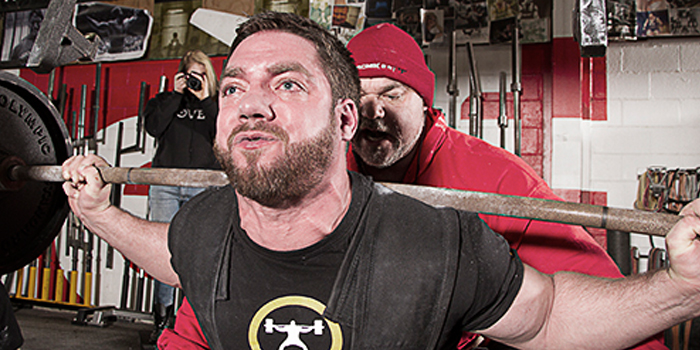
Business and training both take calculated strategy, and there are many concepts that are conducive to success in both.
In my job, I supervise two Graduate Assistants and several Managers (which help to supervise our staff of about 40 employees) and one of the things we do throughout the year is discuss articles on different topics relating to business management and leadership in order to help us run our organization better.
One of the articles we discussed this past year was a piece from Harvard Business Review titled 5 Strategy Questions Every Leader Should Make Time For. The article discussed how important taking time to sit and think through the big picture of your organization is, particularly outside of time when you’re running around putting out “fires.” My mind immediately drew a parallel to training, and how easily we can struggle to see the bigger picture in the midst of the highs and lows of a training session.
RELATED: Lessons Learned from a Corporate Meathead
It can be very easy to let individual moments in training cloud our perspective regarding training as a whole, and for us to lose focus or fall away from the core philosophy that our training is built on. When those times hit (and it happens to the best of us), take time to ask yourself some questions that force you to focus on the big picture and not just the moment in front of you. These five questions will help bring perspective whenever you’re considering making a change in your training, whether big or small:
1. What Doesn't Fit?
In business, there are always new ideas being floated around, and many of them are attractive at first glance. Many of them even work really well individually. The key is, however, to look at how these individual ideas fit into the rest of what you do collectively.
In training it is the same principle and always makes me think of common questions like, “So can I add barbell speed work to my 5/3/1 template?”
Does 5/3/1 work? The evidence of countless lifter’s success makes pretty clear it does. Does speed work benefit training? It certainly can and does for many lifters. But the question is, does speed work fit with the rest of the template you’re following? Would speed deadlifts on your second lower body day fit with your 5/3/1 ‘Boring But Big’ template that already has you doing your 5/3/1 percentage sets and 5x10 of deadlift volume? This is just one example of how individually good ideas still need to fit with the rest of your program.
The author of the Harvard Business Review article described evaluating new ideas this way: “Individually, each of them may seem attractive, but can you explain why they would work well together; why the sum is greater than the parts?”
2. What Would An Outsider Do?
The article mentioned above describes an organization theory called “escalation of commitment.” This is when you’ve committed to something, and fought hard for it (often times for good reasons), but now that it no longer makes sense, you’re still inclined to persist.
We find this same concept apply to training and coaching. While we want to make sure we stay true to our core philosophy in training (and a certain level of stubbornness can be a good thing) we also need to open our perspective outside of just what comes naturally to us.
This is where even if you don’t have a coach, getting outside perspective on your training from experienced people you trust is beyond valuable. You can always reach out to us here at elitefts on our free Q&A for advice regarding your training.
3. Is My Organization Consistent With My Strategy?
This is an important part of evaluating business strategy – do your actions match up with your aspirations? The same goes for training; if you say your goal is to gain strength and increase the three big lifts, does each component of your training support that goal?
Integrity in your training is important in ensuring that you don’t start to spread yourself too thin and “serve too many masters” as the Bible would say. Determine your goals, select your system and build your program from the top down.
4. Do I Understand Why We Do It This Way?
Too many times when you ask the leader in an organization why they do something a certain way, the answer is either a blank stare or “because that’s how we’ve always done it”. The same goes for training. Do you know why you’re doing what you’re doing?
Understanding the “why” is incredibly important in ensuring long-term success, especially as you grow from a beginner to an intermediate or advanced lifter. Follow a program that works, but make sure to educate yourself as you follow it, so you can understand why the program was put together like it was (and why it works or doesn’t).
This is where utilizing a program template like 5/3/1 (as just one example) can be great for beginners looking to get stronger and learn consistency. There are proven methods behind 5/3/1, but you can follow the program without understanding the “why” and still make great progress. Then, as you begin to understand those reasons behind why the program works, it’ll help you in building your own philosophy (and if you continue to train using the program, utilize that program even more effectively).
5. What Might Be the Long-term Consequences?
This final question really ties together all the questions above, in asking how each training decision fits into the big picture. Organizations and their leaders are constantly faced with decisions on whether or not to do something that is good for the short term, but might not be as conducive to long-term success and growth.
This can apply to the broader decisions like meets you choose to compete in, the training partners you surround yourself with, the lifestyle decisions you make, all the way to individual decisions like attempts in a meet and assistance exercises in a training session.
I can’t tell you how many times in a training session I’ve been tempted to do (or not do) something out of ego, fear, or just preference; but I’ve known in the back of my head it’s not going to help me in the grand scheme of things. Your career as a powerlifter is defined by years of collective meets, which are built by weeks upon weeks of training, which consist of countless training sessions, constructed from thousands of exercises, sets and reps. Make sure your decisions on the smallest level keep that big picture perspective in mind, and that you’re building a solid path to long-term success.
References
- 5 Strategy Questions Every Leader Should Make Time For, Harvard Business Review. https://hbr.org/2015/09/5-strategy-questions-every-leader-should-make-time-for













1 Comment